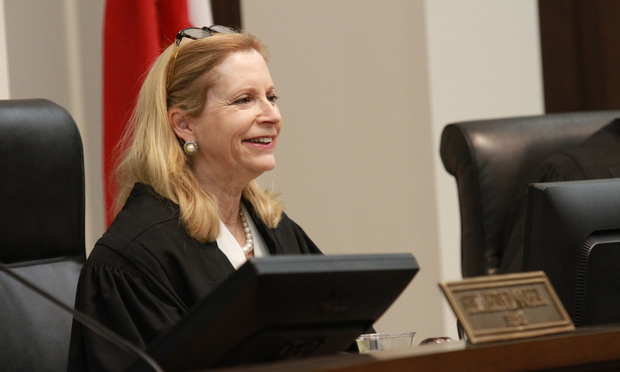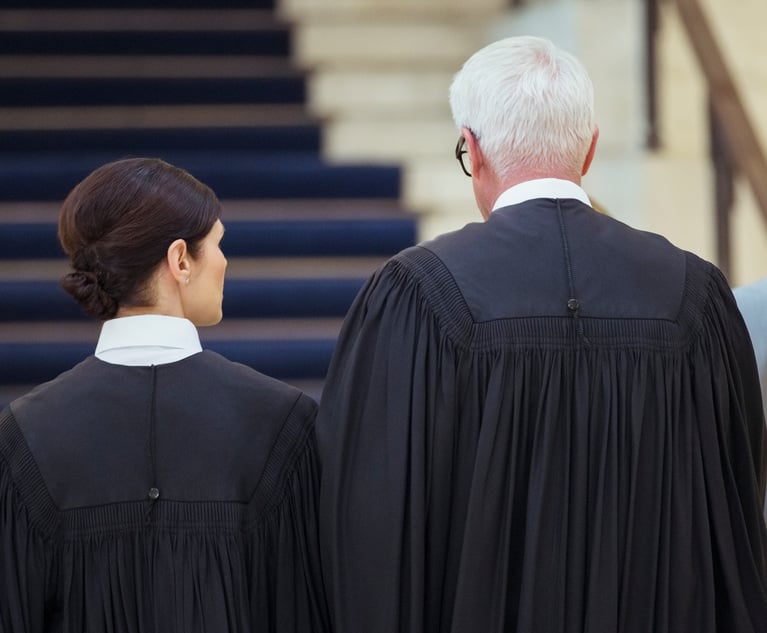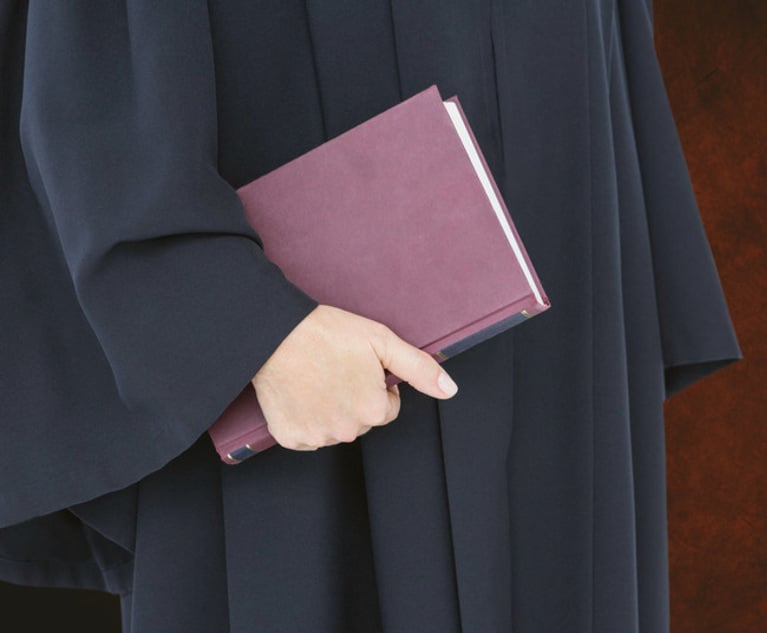Christening the New Courthouse: Divorce, Pollution and a Tiny Technical Glitch
"The faintest praise I can give is that it has exceeded all our expectations," Presiding Judge Anne Barnes said.
January 07, 2020 at 08:27 PM
5 minute read
 Presiding Judge Anne Elizabeth Barnes, Georgia Court of Appeals. (Photo: John Disney/ALM)
Presiding Judge Anne Elizabeth Barnes, Georgia Court of Appeals. (Photo: John Disney/ALM)
Disputes over divorce and environmental pollution played out Tuesday for the first oral arguments ever in the new $131 million, 215,000-square-foot Nathan Deal Judicial Center.
The Georgia Court of Appeals heard about a complicated divorce between an Atlanta couple—King v. King—and a dispute over allegations that runoff from a coal yard sickened a worker at a neighboring business in Columbus—Wylee Toms v. William Buck Jr.
But the star of the day was the new building on Memorial Drive, the first exclusive home for the state's high and intermediate appellate courts—the Georgia Supreme Court and Court of Appeals. The building was finished—minus an extensive punch list—in December. The judges, justices and staff moved in before the holidays. But Tuesday was the first public event there.
About five minutes before the 1:30 p.m. start time, Court of Appeals Clerk Steve E. Castlen welcomed visitors to the roomy second floor courtroom sporting blue carpet with gold stars, an oval-shaped backlit ceiling inset and four simple white Doric columns behind the dark walnut-colored bench.
Castlen took note of the historic occasion and thanked everyone for coming. He mentioned that the court had been in its last home—the state Law Department building across the street from the Capitol—for 60 years.
"We're hoping this one lasts for 100 years," he said.
Then Castlen went over the ground rules. Same as before: 15 minutes for each side, with a clock counting down. When it runs out, "Finish up your thought, or else we get law enforcement involved," Castlen joked.
Five minutes later, the three-judge panel entered the courtroom right on time: Presiding Judge Anne Barnes, the longest-serving member of the court, having joined in 1999; Judge Elizabeth Gobeil; and Senior Judge Herbert E. Phipps, who is retired but currently filling a vacancy.
Barnes also marked the historic significance of the day and thanked former Gov. Nathan Deal—who led the visioning and the funding for the new building that now bears his name and who also appointed more of the judges now serving there than any of his predecessors. He did that in part by expanding both the appellate courts—taking the Supreme Court from seven to nine members and the Court of Appeals from 12 to 15.
"The faintest praise I can give is that it has exceeded all our expectations," Barnes said.
The only snafu was ever so tiny. For a moment, the judges' computer screens went blank in the middle of an argument being made by S. Lester Tate III of Akin & Tate in Cartersville. Barnes had to ask Tate to please stop.
The item that disappeared from their view was still visible to the audience on the big screens above both sides of the courtroom. It was a yellow-lined legal pad sheet outlining Tate's five key points. He had already asked forgiveness for his handwriting. The whole drama was over in seconds—which Tate added on to the end of the argument to make one more point in rebuttal to his opponent, David Helmick of Waldrep, Mullin & Callahan in Columbus. Helmick was defending the property owner being sued.
The first argument of the day—and of the next century, if the building lasts as long as Castlen hopes—was made by William V. "Bill" Custer of Bryan Cave Leighton Paisner. Custer was able to cite the court's precedent in cases he argued there himself, and opinions written by current judges on the court and others who have moved on to the Supreme Court. Custer argued for the wife in the divorce case.
R. Scott Berryman of Berryman Family Law argued for the husband.
Other panels of Court of Appeals judges will hear more cases in their new courtroom this week and onward. The Georgia Supreme Court's first oral arguments are scheduled for next Tuesday. Workers were still putting the finishing touches on the justices' sixth and top floor courtroom Tuesday.
At first glance, the high courtroom appears similar but upgraded ever so slightly. Same blue carpet with gold stars. Ionic columns instead of Doric, and they appear to be marble instead of plain white. The high court's back-lit ceiling insert is round instead of oval. Both are surrounded by another larger ring of pleasantly not-too-bright lights.
Opposite both courtrooms are arching windows facing the Capitol's gold dome. Every floor overlooks an atrium. A winding staircase connects the first two. The whole effect is far more airy and open than the courts' former quarters.
Justices could be seen here and there on different levels escorting visitors around their new home. A tour for legislators is planned for later this month, and a formal dedication ceremony is set for 10:30 a.m. on Feb. 11. The former governor whose name is on the building will headline that program.
This content has been archived. It is available through our partners, LexisNexis® and Bloomberg Law.
To view this content, please continue to their sites.
Not a Lexis Subscriber?
Subscribe Now
Not a Bloomberg Law Subscriber?
Subscribe Now
NOT FOR REPRINT
© 2025 ALM Global, LLC, All Rights Reserved. Request academic re-use from www.copyright.com. All other uses, submit a request to [email protected]. For more information visit Asset & Logo Licensing.
You Might Like
View All
Spalding Jurors Return $12M Verdict Against State Farm Insurance Client
10 minute read

Law Firms Mentioned
Trending Stories
- 111th Circuit Rejects Trump's Emergency Request as DOJ Prepares to Release Special Counsel's Final Report
- 2Supreme Court Takes Up Challenge to ACA Task Force
- 3'Tragedy of Unspeakable Proportions:' Could Edison, DWP, Face Lawsuits Over LA Wildfires?
- 4Meta Pulls Plug on DEI Programs
- 5On the Move and After Hours: Meyner and Landis; Cooper Levenson; Ogletree Deakins; Saiber
Who Got The Work
Michael G. Bongiorno, Andrew Scott Dulberg and Elizabeth E. Driscoll from Wilmer Cutler Pickering Hale and Dorr have stepped in to represent Symbotic Inc., an A.I.-enabled technology platform that focuses on increasing supply chain efficiency, and other defendants in a pending shareholder derivative lawsuit. The case, filed Oct. 2 in Massachusetts District Court by the Brown Law Firm on behalf of Stephen Austen, accuses certain officers and directors of misleading investors in regard to Symbotic's potential for margin growth by failing to disclose that the company was not equipped to timely deploy its systems or manage expenses through project delays. The case, assigned to U.S. District Judge Nathaniel M. Gorton, is 1:24-cv-12522, Austen v. Cohen et al.
Who Got The Work
Edmund Polubinski and Marie Killmond of Davis Polk & Wardwell have entered appearances for data platform software development company MongoDB and other defendants in a pending shareholder derivative lawsuit. The action, filed Oct. 7 in New York Southern District Court by the Brown Law Firm, accuses the company's directors and/or officers of falsely expressing confidence in the company’s restructuring of its sales incentive plan and downplaying the severity of decreases in its upfront commitments. The case is 1:24-cv-07594, Roy v. Ittycheria et al.
Who Got The Work
Amy O. Bruchs and Kurt F. Ellison of Michael Best & Friedrich have entered appearances for Epic Systems Corp. in a pending employment discrimination lawsuit. The suit was filed Sept. 7 in Wisconsin Western District Court by Levine Eisberner LLC and Siri & Glimstad on behalf of a project manager who claims that he was wrongfully terminated after applying for a religious exemption to the defendant's COVID-19 vaccine mandate. The case, assigned to U.S. Magistrate Judge Anita Marie Boor, is 3:24-cv-00630, Secker, Nathan v. Epic Systems Corporation.
Who Got The Work
David X. Sullivan, Thomas J. Finn and Gregory A. Hall from McCarter & English have entered appearances for Sunrun Installation Services in a pending civil rights lawsuit. The complaint was filed Sept. 4 in Connecticut District Court by attorney Robert M. Berke on behalf of former employee George Edward Steins, who was arrested and charged with employing an unregistered home improvement salesperson. The complaint alleges that had Sunrun informed the Connecticut Department of Consumer Protection that the plaintiff's employment had ended in 2017 and that he no longer held Sunrun's home improvement contractor license, he would not have been hit with charges, which were dismissed in May 2024. The case, assigned to U.S. District Judge Jeffrey A. Meyer, is 3:24-cv-01423, Steins v. Sunrun, Inc. et al.
Who Got The Work
Greenberg Traurig shareholder Joshua L. Raskin has entered an appearance for boohoo.com UK Ltd. in a pending patent infringement lawsuit. The suit, filed Sept. 3 in Texas Eastern District Court by Rozier Hardt McDonough on behalf of Alto Dynamics, asserts five patents related to an online shopping platform. The case, assigned to U.S. District Judge Rodney Gilstrap, is 2:24-cv-00719, Alto Dynamics, LLC v. boohoo.com UK Limited.
Featured Firms
Law Offices of Gary Martin Hays & Associates, P.C.
(470) 294-1674
Law Offices of Mark E. Salomone
(857) 444-6468
Smith & Hassler
(713) 739-1250







